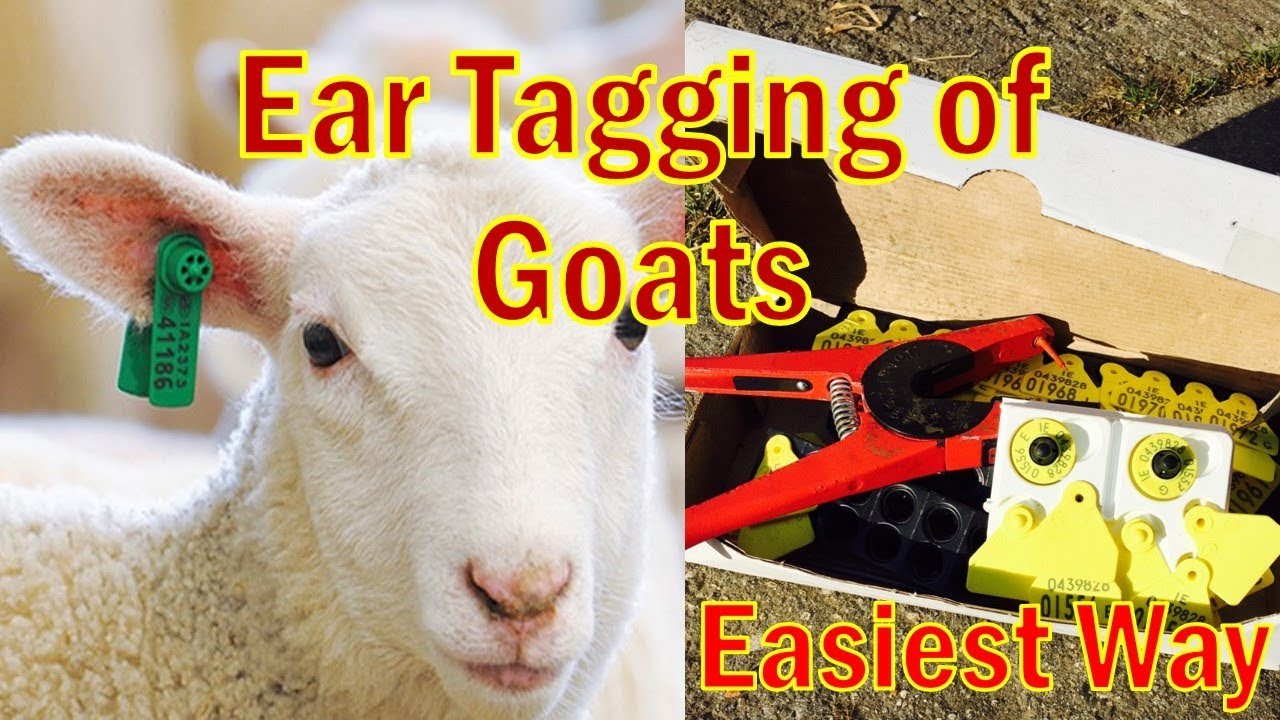Ear Tagging of Goats – Easy way of identification of farm goats
Livestock farmers understand the value of their animals as they depend upon them to fulfil daily needs. This makes it necessary to differentiate between their and others’ animals. For thousands of years, people have been using various animal identification methods; however, along with livestock farming developments, several new techniques have become prominent these days.
Farmers generally establish the identity a few hours or days after the birth of an animal. Animal identification is a much-ignored aspect that is vital for Livestock farming. Let’s read about some of the most common and effective animal tagging methods and their benefits.
Methods of Identifying Farm Animals
- Tattooing
Tattooing is one of the oldest permanent tagging methods, which involves needle-like projections on animal skin, mostly on one ear. They fill ink into the punctures forcibly, leaving the tattoo visible once the wounds heal. Equipment used for this method should be sterilized before use to ensure the animal remains safe against any infection or disease. Usually, old tattoos are not easily identified, and you may require bright light to read.
- Number Tagging
Number tagging involves large metal tags that are readily identifiable from a reasonable distance. Farmers simply attach metal tags with neck chains and loosely fasten the chains around animals’ neck. Though it is a traditional method, the tags may get lost, which is a significant disadvantage. Number tagging is widely used for donkey, sheep, goat, cattle, and rabbit.
- Ear Tagging
Ear tags, unlike tattoos, can be read from a distance; you don’t need to catch the animal to identify. Ear tags are commonly used for animal identification in animal husbandry. Farmers must note down the number that is assigned to their animal and mark the cartilage ribs of ears before putting in the ear tag. The tag will help farmers to identify their animals and record farm details easily.
- Ear Notching
Ear notching is an easy way to identify animals, commonly used for goats, rabbits, pigs, sheep, etc. Following this method, a professional livestock worker makes notch by cutting a small portion of the animal ears. Each notch represents a number that goes according to its location on ears, for example, top-end, bottom, extreme left, and many times, left/right ear also helps differentiate animals.
- Branding
Branding is another effective method for animal identification, which is generally done during the very young age of the animal. Under this technique, a heated tool having a number or symbol is gently pressed on the animal’s body, usually the back. Once the skin tissues are partially burned and healed, the number/symbol starts appearing and remains permanent for long. A similar method, paint branding, is also used for temporary bases.
- Nose printing
Nose printing represents a few of the most accurate permanent identifications; unlike in other cases, it is almost impossible to modify. It is a common practice for farmers that regularly participate in exhibitions and sales of cattle and sheep. Nose printing, similar to fingerprinting, helps identify ownership using lines and dotted pattern which are unique on each animal’s nose.
- Microchip Insertion
The microchip identification method is the latest due to the technology included. A microchip is inserted in animals’ ear or tail, allowing a permanent identification of ownership or the place the animals belong to. Livestock experts often recommend this method as animals feel just a pinch of pain when the microchip is inserted. After insertion, it is vital to scan the chip to ensure it is working correctly. The microchip is necessarily required at some livestock shows and exhibitions.
Benefits of Animal tagging:
- Livestock farmers or animal breeders can easily maintain records of animals.
- It helps treating animals with the availability of past records.
- Easily choose replacement stock before the coming breeding season.
- Track behaviour and movement of the animals.
- Establish ownership.
- Animal tagging is mandated for insurance claims.
- Study and manage your animals (for research purposes).
You might give names to your animals and identify them with the same, but this method might work for a small animal farm but not when you have to handle a large herd of different animals. Therefore, animal tagging is essential; and nowadays it is easier too, you may choose any suitable method from the above-described. You still might have several queries before you tag your animals, need not worry
How to tag your Goats
It is very important that goats are tagged so that they can be easily identified especially for serious goat producers who are keen on maintaining records of their quality animals. Tagging should be done before the animal reaches the age of six months.
The need for record keeping cannot be over emphasised as it gives the farmer data on how well the animals are performing thus enabling proper management decisions to be taken. Although there are various methods for tagging animals, the most frequently used for goats are ear tags.
Tagging Hygiene
Hygiene is always important when tagging your animals to reduce the risk of infection.
- Tools for tagging should be cleaned before and after use.
- Store tagging applicator and tags in a clean airtight container.
- Always clean the area on the animal to be tagged before the process begins.
- After tagging. Check the tagged area regularly to ensure that the area is not infected.
Rubbing alcohol or a disinfectant should be used to clean the tools for tagging and the site on the animal to be tagged.
Types of Tags
There are several tag types and colours which can be used for easy identification of animal.
Tags may also be numbered or unnumbered. Colours can be used to identify birth type (single, twin or triplet) as well as the sex of the animal (male female). Each tag has a male and female end.
Strip tags – are well suited for newborn dairy animals, fibre animals and tail tagging.
Panel tags are ideal for pasture animals, meat animals and for producers who want more visual identification.
RFID (Radio Frequency Identification) tags will appeal to goat producers who want to use an electronic management system
12 Steps to tagging your goats
- Make sure you have all the items needed to begin tagging.
- Before applying the ear tag, be sure to record the number to be assigned to the goat.
- There are some tags that are pre numbered; if not use a permanent marker to indicate number on tag. When completed load the tag in the applicator.
- Place the female component of the tag on the base, seating the plug into the cavityof the tagger, below the metal plate. The metal plate will serve to hold the female component in place. Place the male component of the tag on the tagger pin on the opposite side. Dip the jaws of the applicator holding the tags into an antiseptic solution.
- Squeeze the handles of the tagger to check that the pinslides easily into the hole on the opposite end of the tagger, to ensure that the halves of the tag will meet in proper alignment.
- Restrain your goat kid by holding it allowing free access to the ear to be tagged.Older goats will require more constraint and can be straddled and their head pressed against your attendant’s thigh for ease.
- Identify the area on the ear to be tagged. Be sure to go between the large veins in your goat’s ears. The veins are located in the large creases in the ear.
- Clean area identified for tagging with alcohol. A few farmers have used ice to numb the area to be pierced
- Position the ear tagger over the area you have selected and give it a strong squeeze.
- Ear tagging causes about as much pain as getting your own ears pierced. Goat kids will want the comfort of their dam after the ear tagging is finished.
- When you are done, you will have an easy-to-read identification number on your goat that can be used for herd records and health certificates.
- Watch the animal over the next week for signs of infection or tissue death associated with the ear tag. If severe pain, redness, or discharge develops, the tag may need to be removed and replaced at a later date after a course of antibiotic treatment and resolution of the infection.
How to tag livestock properly
Tagging livestock is an important part of animal identification but must be done properly to keep the animal from losing its tag or getting an infection. Before starting, make sure you have the proper ear tags and tag applicator.
1Secure the animal
Properly secure the animal to limit the animal’s head movement during the tagging process. Limiting head movement prevents improper tagging or injury to the animal or human doing the tagging.
For cattle, use a cattle chute with a head gate, halter and/or nose lead. Confine swine in a small pen, use hog boards, or a hog snare to completely secure the pig. For sheep and goats, properly grip the animal’s head to hold it in place.
2Disinfect
Proper hygiene is necessary to prevent infections. Use rubbing alcohol or disinfectant to clean the applicator as well as the tagging site in the ear.
3The applicator
Place each half of the tag onto the applicator. The stud must be completely onto the applicator pin and the panel/button portion must be under the opposite clip. Make sure the applicator pin is not bent or broken.Make sure the applicator is aligned before tagging the animal by closing the applicator to the point where the two halves meet; the stud should be centered with the hole.
Make sure the applicator is aligned before tagging the animal by closing the applicator to the point where the two halves meet; the stud should be centered with the hole.
4Tagging site
Identify the tagging site on the ear. Tags should be placed in the middle third of the ear between the upper and lower ribs. Tags placed too far outside the recommended area are prone to snagging and getting ripped out, while tags too far inside the animal’s ear could cause pinching or necrosis.
When applying electronic identification (EID) tags, apply tag with the visual panel, male portion, of the tag on the outside back of the ear with the EID button, female portion, of the tag inside the ear.
5Tagging
Position the applicator in the identified tagging site on the animal’s ear. Firmly and quickly close the applicator, and release.
Inspect the tag to verify it is in correctly, comfortably and securely. Record the necessary data on the animal.
6Watch for infection
Once the animal has been tagged, monitor the tagged area for infection. Apply hydrogen peroxide directly to the ear tag puncture for five to seven days to prevent infections. If a serious infection occurs, consult your veterinarian.

Compiled & Shared by- Team, LITD (Livestock Institute of Training & Development)
Image-Courtesy-Google
Reference-On Request.


